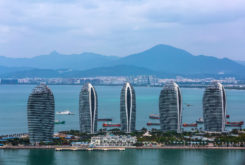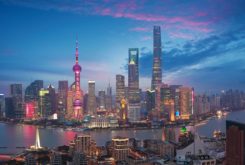On April 26, a new state-of-the-art terminal opened at the Bai Yun (White Cloud) Airport of Guangzhou. It is the largest terminal building in the mainland, with 658,700 square metres of floor space. It is the latest example of the dense transport system being built by cities in Guangdong province, Macao and Hong Kong, as part of the construction of the Greater Bay Area (GBA).
Guangdong has five airports, of which Guangzhou and Shenzhen are the largest. In addition, Macao and Hong Kong have international airports.
The GBA is also blessed with a dense network of railways, highways, rivers and canals served by boats and jetfoils. These services are both complementary and at the same compete fiercely with each other.
Guangzhou, the provincial capital, is the centre of this network. With four railway stations, it has an extensive system linking it with the rest of China; it is the main express hub connecting north and south China. It is building a network of inter-city and high-speed trains, connecting it to Nanning, Guiyang, Shenzhen and Zhuhai. This network will enable travellers from outside Guangdong to reach White Cloud Airport, Nansha Port and other ports.
It aims to make every city in the GBA within one-hour travelling time of Guangzhou. One of these will be a high-speed train to Shenzhen and Hong Kong that is due to open in the second half of 2018. Hong Kong is building a four-million-square-foot station for the new trains. The travel time to Guangzhou will fall to one hour from about two hours now on a conventional track.
In Hong Kong, the project is controversial. First, opponents ask why it was necessary to spend US$10.7 billion and seven years to build a line that will reduce the travel time by merely one hour. Second, they adamantly oppose the presence of mainland officials in the new station; they say this contravenes the Basic Law, which forbids the implementation of mainland law in the SAR. The government denies this.
The debate in Hong Kong’s Legislative Council became so bitter on June 13 that security guards evicted five pan-democratic legislators who were protesting against a cut-off in the debate on the issue.
There is scepticism also in Hong Kong about another Pharaonic project that is part of the new transport network in the GBA.
This is a bridge/tunnel that will connect Hong Kong with Macao and Zhuhai and is due to open later in 2018. It will be the first vehicular connection between Hong Kong and the western side of the Pearl River.
It runs 55 kilometres, the longest bridge in the world, and is costing US$16 billion. But the number of vehicles using it will be restricted, because neither Macao nor Hong Kong want a large number of vehicles onto their already congested roads. So most of the traffic will go to two large man-made islands at either end; travellers will leave their vehicles, pass through customs and immigration and take local buses and taxis.
This bridge faces competition from the Humen Bridge over the Pearl River, which connects Nansha in Guangzhou to Humen in Dongguan; it opened in 1997. Even more serious will be the Shenzhen-Zhongshan bridge, which connects Shenzhen on the east side of the Pearl River with Zhongshan on the west. It is 27 km downstream from the Humen bridge and 32 km north of the HK-Macao-Zhuhai bridge. Costing about US$5 billion, it is due for completion in 2021.
The toll on the Shenzhen-Zhongshan will be substantially cheaper; and users will not have to go through customs or immigration, since both cities are in mainland China.
The three bridges will face competition from Shun Tak-China Travel Ship Management Company, based in Hong Kong. It currently operates hydrofoil ferry services, with the brand name TurboJet, between Hong Kong, Macao, Shenzhen, Zhuhai and Guangzhou.
Its busiest route is the one between Hong Kong and Macao, operating 24 hours a day. The company has not announced its strategy for competing with the buses that will run every 15 minutes across the new bridge and threaten to take away many of its customers, especially gamblers.
Guangdong province is blessed with an extensive network of express roads, which connect the major cities of the GBA.
So, as the transport network becomes more dense, there will be winners and losers. No-one knows for sure if there will be sufficient demand for all the new capacity that is being built.



